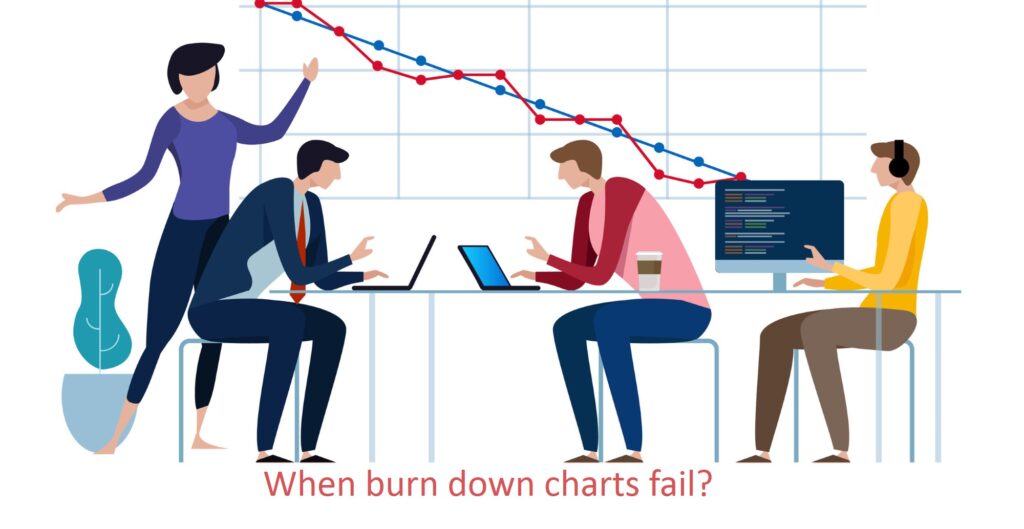Last Updated on October 28, 2024 by Techcanvass Academy
Burn Up and Burn Down Chart are essential tools that project managers use in Agile project management. These charts are used to track the progress of the agile project and communicate the same to stakeholders or other members associated with the project.
A burndown chart is used to visually display the amount of work remaining for an agile project, while a burnup chart displays the amount of project work that has been completed and also shows the total project work. Both these tools are a crucial part of agile methodology as they enable the project managers to constantly keep a track of the project progress and ensure that the work is being completed within the deadlines.
In this guide, let us learn more about what is Burn Up and Burn Down Chart are?
What Is a Burndown Chart?
Burndown charts show the status of the remaining quantum of work. The project data is collected using the burndown chart to visually represent how much work or project tasks are still left and how much time is left for doing these tasks.
In simple words, a burndown chart is a graphical representation of words that may not be able to clearly communicate the project progress to the team or stakeholders. Therefore, a burndown chart plays a crucial role in informing the agile team about the total effort against the amount of work within each iteration.
How To Use Burndown Charts in Agile Methodology?
Burndown charts are used in agile scrum methodology as it is all about iterative development as and where there are some customer feedbacks or changes needed. These charts help in managing deadlines as new user stories are incorporated into the project.
The burndown charts are graphically represented through a graph. The quantum of work is shown on the Y-Axis whereas the timeline is shown on the X-Axis. The X-axis is also known as the project or iteration timeline. On the other hand, the Y-axis shows all the work that needs to be completed within the iteration timeline.
One way to understand the burndown chart is through the following examples:
The quantum of work is shown on the Y-Axis whereas the timeline is shown on the X-Axis. This is a simple yet effective visual representation of project progress, as shown below:
As you can see, We have used the quantum of work in days. However, we can also use story points or any other unit as well. It’s an easy-to-use chart and it tells the story visually. This chart, above, is for a sprint of 4 weeks.
The Best Burndown Chart Tool
A few examples of good burndown chart tools are as follows:
- Jira software
- Monday,com
- Trello burndown chart
- Excel
Here is an example to better understand burndown chart creation:
We have used Microsoft Excel to create the burn-down chart. Excel provides the maximum flexibility, however other tools like JIRA or the above-mentioned options can also do the same.
For this post, We have used an e-commerce project to create this burn-down chart. The chart is created using the following backlog tracking sheet:
This is a snapshot of the data. The total number of estimated days for this project is 56 days and the release date is 28-Feb-2017.
What Is Burn Up Chart in Agile?
Burn-up charts are the graphical representation of the amount of work completed in the project over a period of time. This means that it shows the info, which burn-down charts don’t. This makes them perfect foil to each other.
The burnup chart has a Y-axis that denotes the amount of work, while the X-axis denotes the iteration timeline. Let us understand the burnup chat with an example.
A burn up chart is shown below:
The Blue line shows the total amount of work in the project. The Saffron line shows the work completed in the project. Both the curves converge, if there is no change in the scope, as shown in the diagram.
How Do Burnup Charts Help Agile Project Management?
Burnup charts are a great tool in agile project management as they can help track if the agile team is on track to complete the project. The agile project management can determine how effectively the team is working and how much of the project has been completed so far.
Moreover, the agile team can also update the project or iteration timeline as needed by estimating how much time it will take to complete the remaining project work.
What Is the Best Burn-Up Chart Tool?
You can easily create burn up charts by using the following tools:
- Jira
- Excel
- MOOVIA
- ClickUp
Useful Link – IIBA Agile Analysis Certification Training
Burn Up and Burn Down Chart – What’s The Difference?
Here are some differences between the burnup charts and burndown charts:
| Burndown Chart | Burnup Chart | |
| Use | The burndown charts are used to determine how much project work is still remaining and what is the project timeline within which the work is to be completed. | On the other hand, burnup charts are used to showcase the project work that has been completed so far within the project timeline. |
| Information transparency | Burndown charts are not ideal when it comes to information transparency if there are changes in the product scope. These charts do not show the information regarding the changes in the timeline. | Burnup charts are ideal for information transparency regarding any changes in the product scope within the iteration deadline. |
| Proper communication | The primary purpose of burndown charts is for communicating purposes. However, when new tasks or scope are added to the product, these charts may not be able to properly measure the efficiency of the project team. | The main goal of burnup charts is also to act as a communication tool. However, even with additional tasks or project scope, these charts can easily measure the efficiency of the project team. |
| Target audiences | Burndown charts are considered more basic than burnup charts. Therefore the target audience for these charts would be people who want insights about the project progress at any point in time and nothing else. | The burnup charts on the other hand are appropriate for audiences who want to get an in-depth understanding of how the project manager has managed the project so far within the project deadline. |
Benefits Of Using a Burndown and Burnup Chart
Benefits of a Burn-down chart
The benefits of a burndown chart are as follows:
- These charts are a simple and comprehensive way for project managers to control project sprints.
- They give an overview of the remaining project work.
- One can recognize project risks with the help of a burndown chart through regular updates.
- The project manager or the stakeholder can get an idea of whether the scrum team is on track and working as per schedule or not.
Benefits of a Burn-up chart
The benefits of a burn-up chart are as follows:
- Burnup charts are easy to understand and are a simple way of controlling the project.
- They are good for showcasing any changes in the project scope or any add-ons to the project tasks.
- Burnup charts show a complete overview of the project work that has already been done.
- These charts are good for determining whether the project is progressing as per schedule or not.
Useful Link – IIBA Agile Analysis Certification Training
Limitations Of Using a Burndown and Burnup Chart
You can also come across a few limitations when it comes to using burn-down charts. Although they may be easy to comprehend and work with, one of the drawbacks of using burn-down charts is that it does not display any changes in the scope of the project. For instance, if you are analyzing the sprint burndown, you will not find the scope changes for the rest of the backlog.
Another limitation of a burndown chart is that it shows the work progress from a backlog perspective only, which means you don’t get to see the whole picture.
Conclusion
The decision to choose a chart is dependent on the overall project goal tracking. How is the team comfortable in tracking the progress of the project? You may integrate both charts into your product lifecycle. If your goal is to look at the remaining work to be done, then a burndown chart is the best option. If you are looking to track the work completed vs the overall work, then a burnup chart is the best option.
These charts can help you keep your team informed so that the members of the team can work collaboratively towards a common goal. Furthermore, it is important to keep in mind that these charts are incredibly flexible, and you can implement them alongside your agile or scrum framework.
Frequently Asked Questions (FAQs)
You can easily create a burn up or a burn down chart using various chart tools such as Excel, Jira software, or any other.
A burn down chart is a graphical representation of the remaining project work against the project timeline. The remaining work is depicted on the vertical or the Y-axis on the graph, while the project timeline is depicted using the horizontal line or the X-axis on the graph.
Burn up charts are easy to read and understand, The Y-axis represents the amount of work completed and the X-axis denotes the timeline within which the project work has been completed. And ultimately, you can figure out how much work is remaining by looking at the distance between the lines on the chart.
To read a burn down chart, one can compare the two lines on the graph. If the lines on the graph are closer to each other, then you have better chances of completing the project within the deadline.
The average burn down rate is known as the ideal burn down line. It is used to guide the project team through the project development. The average burn down line starts from the top of the Y-axis and ends at the right-most part of the X-axis.
The scrum burn down chart shows the completed project tasks per day against the projected rate of completing the project.



